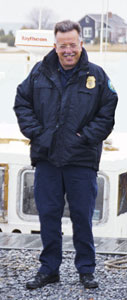Man Is Killed Trying to Turn Onto Highway
Man Is Killed Trying to Turn Onto Highway

Byron C. Preiss, 52, an author and publisher who divided his time between Manhattan and Bull Path, East Hampton, was killed on Saturday morning when he pulled his car out onto Montauk Highway in front of a westbound Hampton Jitney.
According to East Hampton Village police, Mr. Preiss was attempting to make a left-hand turn from Stephen Hand's Path onto the highway at 11:15 a.m. The Jitney, piloted by Zissis Sioutopoulos of Patchogue, was traveling at 30 miles per hour, police said.
Mr. Sioutopoulos swerved when he saw Mr. Preiss's Chrysler P.T. Cruiser but was unable to avoid hitting the driver's side of the car, he told police. Several witnesses questioned at the scene confirmed his description of the accident.
Mr. Preiss was on his way to the East Hampton Jewish Center, according to East Hampton Village Police Chief Gerard Larsen.
Fifteen passengers were on the bus, which had front-end damage and a cracked windshield. Kathleen Whelan, a physician who lives on Rhode Island, was reading a book when the accident happened. "Thank God he kept control of the bus," she said of Mr. Sioutopoulos.
Ms. Whelan and several other passengers stepped off the bus to try to help Mr. Preiss. A nurse who had pulled over to the side of the highway helped them to move Mr. Preiss carefully from the car, Dr. Whelan said. The airbag had not been activated, she added.
The nurse held a towel to Mr. Preiss's head and tried to perform cardiopulmonary resuscitation, but Mr. Preiss had no pulse when he was removed from the car, Dr. Whelan said. Minutes later, emergency medical technicians also tried unsuccessfully to revive him.
Police closed part of Montauk Highway for nearly three hours in order to interview witnesses and reconstruct the events of the accident. Traffic was diverted to Route 114.
About a half-hour after the accident, a bicyclist who swerved into Montauk Highway near Cranberry Hole Road in Amagansett was struck by a car. He was flown to Stony Brook University Hospital, and remained in critical condition as of yesterday.
The closing of Montauk Highway at Cranberry Hole Road and at Stephen Hand's Path caused backups in traffic for hours in both directions.
Mr. Preiss's obituary appears on page A2 of today's Star.

